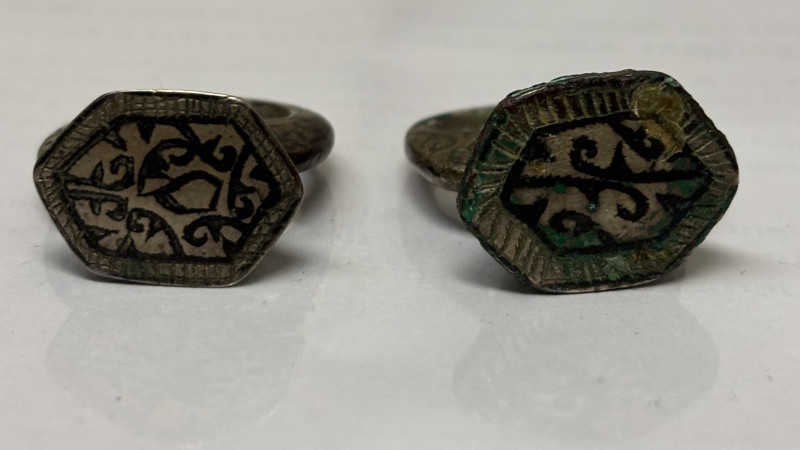
Among the rarest and most intriguing objects in our collection is a pair of ancient silver rings, decorated with dark niello and crowned with a distinctive conical head. Sealed and symmetrical, these rings hold more than just beauty — they carry a mystery that stretches back over 800 years.
Historical Background
These rings are believed to have been crafted in Central Asia, most likely between the 12th and 13th centuries. This period marked the transition from the Samanid to the Ghaznavid dynasties, an era of flourishing Islamic culture and craftsmanship in the cities of Bukhara, Samarkand, and Nishapur.
The rings were reportedly discovered in a hoard that also contained silver coins from both dynasties — a strong indication that they were in use during this dynamic historical period.
Construction and Symbolism
Each ring is cast in silver and richly decorated using niello, a black inlay technique favored by Islamic metalworkers. The head of each ring is conical and sealed, possibly hollow inside — a feature found in rings used as amulets or ritual tokens.
The visible engravings are not fully legible Arabic inscriptions, but rather abstract symbols, executed in the style of pseudo-kufic ornament. Such decorative elements were often meant to resemble sacred writing, offering visual protection or spiritual significance even when not readable.
These are not typical signet rings. They were likely crafted as wedding rings or personal talismans, given in the context of a sacred bond between two individuals.
Cultural Significance
What makes these rings unique is their pairing — a rare example of two nearly identical objects, made with care and intention. In Islamic culture, rings often carried deep personal meaning, and the presence of niello, the symbolic shape, and the sealed interior all point to an item of ritual or protective value.
Their style and technique also suggest continuity of regional artistic traditions, bridging the refined elegance of the Samanid court with the militarized yet culturally rich Ghaznavid state.
Research and Ongoing Questions
While no inscriptions on these rings identify a specific owner or workshop, their form, decoration, and archaeological context place them within a well-documented Central Asian tradition.
Conclusion
These rings are more than jewelry. They are echoes of faith, love, and protection — crafted by unknown hands, worn by unknown lives, yet surviving the centuries as silent witnesses of Islamic Central Asia’s rich cultural heritage.




Leave a comment